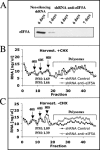The role of polyamines in supporting growth of mammalian cells is mediated through their requirement for translation initiation and elongation
- PMID: 20181941
- PMCID: PMC2857121
- DOI: 10.1074/jbc.M110.106419
The role of polyamines in supporting growth of mammalian cells is mediated through their requirement for translation initiation and elongation
Abstract
Polyamines are essential cell constituents whose depletion results in growth cessation. Here we have investigated potential mechanisms of action of polyamines in supporting mammalian cell proliferation. We demonstrate that polyamines regulate translation both at the initiation and at the elongation steps. L-alpha-difluoromethylornithine treatment resulting in polyamine depletion reduces protein synthesis via inhibition of translation initiation. N1-guanyl-diaminoheptane (GC7), a spermidine analogue that inhibits eukaryotic initiation factor 5A (eIF5A) hypusination, also caused inhibition of translation initiation. In contrast, depletion of eIF5A by short hairpin RNA inhibits translation elongation as was recently demonstrated in yeast and Drosophila. These results suggest that in addition to competing with spermidine in the hypusination reaction, GC7 also competes with spermidine at yet undefined sites required for translation initiation. Finally, we show that either polyamine depletion or GC7 treatment induced eIF2alpha phosphorylation and reduced phosphorylation of 4E-BP, thus setting the molecular basis for the observed inhibition of translation initiation.
Figures






Similar articles
-
Synergistic drug combination GC7/DFMO suppresses hypusine/spermidine-dependent eIF5A activation and induces apoptotic cell death in neuroblastoma.Biochem J. 2018 Jan 31;475(2):531-545. doi: 10.1042/BCJ20170597. Biochem J. 2018. PMID: 29295892
-
Independent roles of eIF5A and polyamines in cell proliferation.Biochem J. 2005 Feb 1;385(Pt 3):779-85. doi: 10.1042/BJ20041477. Biochem J. 2005. PMID: 15377278 Free PMC article.
-
Inhibition of eIF5A hypusination pathway as a new pharmacological target for stroke therapy.J Cereb Blood Flow Metab. 2021 May;41(5):1080-1090. doi: 10.1177/0271678X20928882. Epub 2020 Jul 2. J Cereb Blood Flow Metab. 2021. PMID: 32615885 Free PMC article.
-
eIF5A and EF-P: two unique translation factors are now traveling the same road.Wiley Interdiscip Rev RNA. 2014 Mar-Apr;5(2):209-22. doi: 10.1002/wrna.1211. Epub 2014 Jan 8. Wiley Interdiscip Rev RNA. 2014. PMID: 24402910 Review.
-
Unveiling the novel role of spermidine in leaf senescence: A study of eukaryotic translation factor 5A-independent and dependent mechanisms.Plant Sci. 2025 Apr;353:112408. doi: 10.1016/j.plantsci.2025.112408. Epub 2025 Jan 31. Plant Sci. 2025. PMID: 39894057 Review.
Cited by
-
Oil for the cancer engine: The cross-talk between oncogenic signaling and polyamine metabolism.Sci Adv. 2018 Jan 24;4(1):eaar2606. doi: 10.1126/sciadv.aar2606. eCollection 2018 Jan. Sci Adv. 2018. PMID: 29376126 Free PMC article. Review.
-
Myc, Oncogenic Protein Translation, and the Role of Polyamines.Med Sci (Basel). 2018 May 25;6(2):41. doi: 10.3390/medsci6020041. Med Sci (Basel). 2018. PMID: 29799508 Free PMC article. Review.
-
Functional regulation of cytotoxic T cells by gut microbial metabolites.Gut Microbes Rep. 2025;2(1):1-16. doi: 10.1080/29933935.2025.2454002. Epub 2025 Jan 26. Gut Microbes Rep. 2025. PMID: 40115123
-
Inhibition of Polyamine Biosynthesis Is a Broad-Spectrum Strategy against RNA Viruses.J Virol. 2016 Oct 14;90(21):9683-9692. doi: 10.1128/JVI.01347-16. Print 2016 Nov 1. J Virol. 2016. PMID: 27535047 Free PMC article.
-
Flexible NAD+ Binding in Deoxyhypusine Synthase Reflects the Dynamic Hypusine Modification of Translation Factor IF5A.Int J Mol Sci. 2020 Jul 31;21(15):5509. doi: 10.3390/ijms21155509. Int J Mol Sci. 2020. PMID: 32752130 Free PMC article.
References
-
- Igarashi K., Kashiwagi K. (2010) Int. J. Biochem. Cell Biol. 42, 39–51 - PubMed
Publication types
MeSH terms
Substances
LinkOut - more resources
Full Text Sources
Other Literature Sources
Molecular Biology Databases

